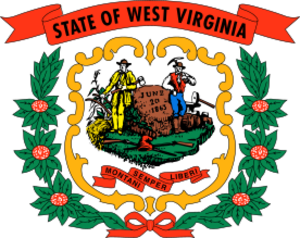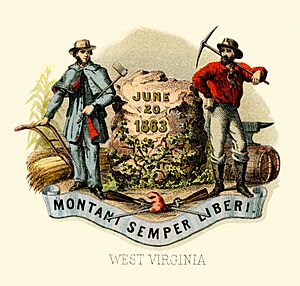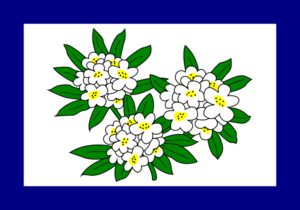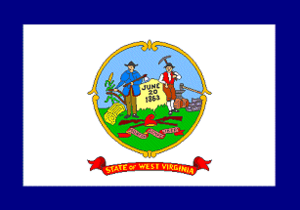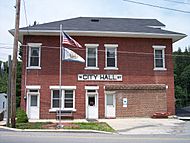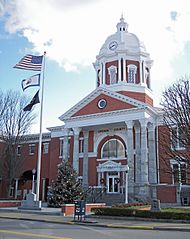Flag of West Virginia facts for kids
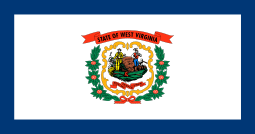 |
|
| Name | West Virginia |
|---|---|
| Use | Civil and state flag |
| Adopted | March 7, 1929 |
| Design | A pure white field bordered on four sides by a stripe of blue with the coat of arms of West Virginia in the center, wreathed by Rhododendron maximum and topped by an unfurled red ribbon reading "State of West Virginia." |
The flag of West Virginia is the official flag of the U.S. State of West Virginia. It was officially chosen by the West Virginia Legislature on March 7, 1929. The flag has a white background with a blue border. In the middle, you'll see the coat of arms of West Virginia. This is surrounded by the state flower, the Rhododendron maximum, and a red ribbon that says "State of West Virginia."
West Virginia's flag is special because it's the only state flag with crossed rifles. These rifles show how important the state's fight for freedom was during the American Civil War. West Virginia became the 35th state, joining the Union.
The first flags for West Virginia were battle flags used by soldiers during the Civil War. The state's first official flag was adopted in 1905. It was based on a flag used at a big event called the Louisiana Purchase Exposition in 1904. This flag was changed in 1907. To make the flag cheaper to produce, the current design was chosen in 1929. It combines the coat of arms and the rhododendron on both sides. In 1977, a special "Pledge of Allegiance to the West Virginia State Flag" was created.
Contents
What the West Virginia Flag Looks Like
The West Virginia state flag has a pure white background with a blue stripe around all four sides. The white color stands for purity. The blue border represents the Union.
In the center of the flag is the state's Coat of Arms. This is a special design based on the Great Seal of West Virginia. Below the coat of arms, you'll see two bundles of Rhododendron maximum, which is West Virginia's state flower.
At the top of the flag, there's a red ribbon that says "State of West Virginia." At the bottom, another red ribbon has the state's Latin motto: Montani Semper Liberi. This means "mountaineers are always free."
Symbols on the Coat of Arms
The coat of arms in the middle of the flag shows what West Virginia is known for.
- In the center, there's a large rock covered in ivy. It has the date "June 20, 1863" carved into it. This is the day West Virginia became a state.
- In front of the rock are two crossed hunting rifles and a Phrygian cap. This cap is a symbol of freedom. These items show the state's fight for liberty.
- Two men stand on either side of the rock. They represent agriculture (farming) and industry.
- The farmer is on the left. He holds an ax and a plow, with cornstalks behind him.
- The miner is on the right. He holds a pickax, and behind him are an anvil and a sledge hammer.
The West Virginia flag has the same size proportions as the flag of the United States. For parades, the flag is often decorated with a gold fringe on three sides. When used with the U.S. flag, it's displayed in a similar way with fringe, cords, and tassels.
How the West Virginia Flag Came to Be
Before the current flag, West Virginia had several other flags after becoming a state in 1863. These earlier flags were not very practical. In 1863, the first West Virginia Legislature asked Joseph H. Diss Debar to design the Great Seal of West Virginia. This seal was adopted in September 1863. However, the state didn't choose an official flag until 1905.
Flags During the Civil War
Before West Virginia became a separate state from Virginia in 1863, people in western Virginia who supported the Union made their own flags. These flags showed their support for the Union cause. For example, in January 1861, people in Kingwood put up a tall flagpole and raised a handmade flag that said "UNION."
During the war, West Virginia soldiers in the Union Army carried flags made by women who supported them. The Fifth Regiment Virginia Volunteer Infantry carried a flag that said "5th Va. Regiment" in 1861.
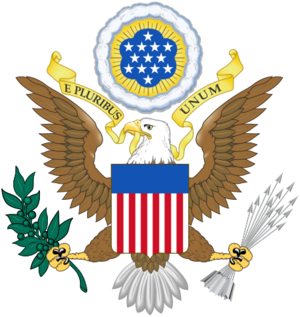
In 1864, the West Virginia Legislature approved a flag for the Fourth Regiment West Virginia Volunteer Infantry. This flag listed the battles the regiment fought, like Charleston and Vicksburg. Many battle flags were used by West Virginia soldiers during the war.
These early state flags were dark blue silk squares, about 6 feet (1.8 meters) wide, with gold fringe. One side had the state's new seal, the regiment's name, and battle names. The other side had the Great Seal of the United States. This seal showed a bald eagle holding arrows and an olive branch, with a shield on its chest. The eagle held a scroll with the Latin motto E pluribus unum, meaning "Out of Many, One." After the Civil War, West Virginia didn't have an official flag again until the early 1900s.
The 1905 Flag
In 1904, West Virginia needed a flag to represent itself at the Louisiana Purchase Exposition in St. Louis. The state commission created its own flag for the event. This flag had a "sprig of mountain laurel upon an immaculate white field with a pale blue border."
The commission suggested this design become the official state flag. On February 24, 1905, the West Virginia Legislature agreed. They added a border of carmine red fringe. This flag was meant to be used when the state needed to show its unique identity.
The 1905 flag was designed to be 9 parts long for every 13 parts wide, just like the U.S. flag. It had the rhododendron on the front and the state's coat of arms and motto on the back. Schools and other places in West Virginia started flying this new flag. For example, in June 1906, schools in Ronceverte bought the new flag and used it for patriotic events.
The 1907 Flag
By 1907, the 1905 flag design caused problems. The lettering on one side was hard to read, and the different colors on each side showed through the white fabric. This made the flag look messy. The West Virginia Legislature wanted to fix this so the state could be properly represented at the Jamestown Exposition in Norfolk.
On February 25, 1907, the legislature changed the flag. They removed the seal and motto from the back. Instead, the back of the flag would also show "a spring or sprigs of the rhododendron maximum." They also changed the fringe color from carmine red to old gold. The front of the flag kept the state's coat of arms and the words "State of West Virginia."
The 1929 Flag: Our Current Flag
The 1907 flag was used until 1929. West Virginia wanted a flag that was cheaper to make, so it could be mass-produced for schools. The 1907 flag was expensive because it had two different designs (the coat of arms and the flower) on each side.
The legislature decided the flag should have one design that combined both the coat of arms and the state flower on both sides. This new design, which is our current state flag, was officially adopted on March 7, 1929.
The 1929 flag has the same proportions as the U.S. flag. It has a pure white background with the state's coat of arms in the center, showing the date West Virginia joined the Union and the motto "Montani Semper Liberi." Above the coat of arms is a ribbon saying "State of West Virginia." Around the bottom of the coat of arms is a wreath of Rhododendron maximum. The white background is bordered by a blue stripe on all four sides. For parades, the flag has gold fringe on three sides.
In 2001, a group called the North American Vexillological Association surveyed flags from U.S. states and Canadian provinces. They ranked the West Virginia flag 51st out of 72 flags. Flags with state seals on plain backgrounds, like West Virginia's, were not as popular in the survey.
How to Use and Display the West Virginia Flag
West Virginia has laws about how its state flag should be used.
- The state flag should never be placed above the flag of the United States. If they are on the same level, the U.S. flag should be to the right.
- Both the U.S. and West Virginia flags are flown at the West Virginia State Capitol building all year.
- Any U.S. or West Virginia flag bought with state money must be made in the United States.
- If a law enforcement officer dies, the state flag can be draped over their coffin for free, if their family asks.
Flying Flags at Half-Mast
Since July 18, 2013, the office of West Virginia Governor Earl Ray Tomblin set rules for flying flags at half-mast on state properties. Both the U.S. and West Virginia flags should be raised all the way up first, then lowered to half-mast. When taking them down, they should be raised to full-mast again before being lowered for the day.
Flags are flown at half-mast on special occasions, like:
- Memorial Day (last Monday in May): Half-mast until noon, then raised to full-mast.
- Peace Officers Memorial Day (May 15): Half-mast all day.
- Patriot Day (September 11): Half-mast all day.
- National Pearl Harbor Remembrance Day (December 7): Half-mast all day.
- For 30 days after a current or former President of the United States dies.
- For ten days after the death of the Vice President of the United States, the Chief Justice of the Supreme Court, or the Speaker of the United States House of Representatives.
- From the day of death until the burial of a former Vice President, a Supreme Court Justice, a Secretary of a U.S. department, or a Governor of a U.S. state.
- On the day of death and the next day for a member of the United States Congress.
- Other times when the Governor of West Virginia announces it.
Protecting the Flag
West Virginia state law says that damaging the U.S. flag or the West Virginia state flag is a minor offense. If someone is found guilty, they could face a fine or jail time.
However, the Supreme Court of the United States has ruled that these laws cannot be enforced. This is because the First Amendment to the United States Constitution protects "symbolic speech," which includes actions like flag desecration. This means people have the right to express themselves, even in ways that others might find offensive.
Pledge of Allegiance to the West Virginia Flag
On February 8, 1977, the office of the Secretary of State of West Virginia officially adopted the "Pledge of Allegiance to the West Virginia State Flag." The pledge says:
I pledge allegiance to the flag of West Virginia, which serves as a constant reminder that "Mountaineers Are Always Free," which stands as a symbol of her majestic mountains, fertile forests, rich veins of coal, and the pride of her people.
Images for kids
See also
 In Spanish: Bandera de Virginia Occidental para niños
In Spanish: Bandera de Virginia Occidental para niños


